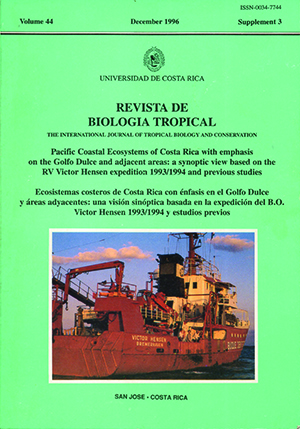Abstract
Golfo Dulce is a deep tropical estuary whose ecosystem dynamics are poorly understood. In order to evaluate biomass and energy now distributions, productivity potential. and to obtain guidelines for conservation management, a steady - state model of 20 compartments (excluding detritus) was constructed using the: ECOPATH II software. Total system biomass (10.4 t/km2) and total energy throughput (sum of all flows, T = 1405 t/km2/year) of Golfo Dulce are small compared to other modeled coastal ecosystems. The mayor pan of the energy throughput is achieved from primarily pelagic trophic levels I to II (52%) plus 11 to III (41 %). The pelagic fish biomass consumed with in the system by top predators (about 1133t) exceeds twice The demersal fish biomass consumed (5021). Artesanal fishery primarily operates on the top trophic levels of the benthic domain and has a very low gross efficiency (catch/ primary production = 0.06%). A nearly balanced production/repiration ratio (P/R = 1.09) and a high mean tranfer efficiency (15%) suggest that the system is near maturity. Contradictory seem the low Ascendency (A= 32.2%) and high development Capacity (OC = 61.8%) values indicative of a relatively undeveloped system of little internal stability. This contradiction might be explained through the fact that much of the detrital matter produced within the euphotic zone is sedimented away and does not - like in other coastal systems - reenter the food web. Thus, whereas the pelagial represents a tightly coupled rather mature (sub) system, the Golfo Dulce as a whole lacks this degree of maturity due to a very inefficient benthic pelagic coupling, which results from its fjord-like topography. The model reveals that Golfo Dulce acts differently from most tropical coastal ecosystems: it is dominated by biomass and energy flow within the pelagic domain and ruther resembles an open ocean system than an estuarine one. Due to its low benthic biomass and low overall productivity, there seems to be no potential for further development of the demersal/semi-demersal fishery inside the gulf. An increase of the pelagic fishing pressure would seriously threaten the populations of resident predators such as dolphins, sharks and large bird species. which have considerable conservation and ecotourism values. Future ecosystem research in Golfo Dulce should focus on the pelagic part of the gulf (microbial loop, plankton, and nekton), on the small benthos. as well as on transfer processes within the pelagic: domain, between the pelagial and the brnthos, and at the river/gulf and gulf/ocean interfaces.Comments

This work is licensed under a Creative Commons Attribution 4.0 International License.
Copyright (c) 1996 Revista de Biología Tropical
Downloads
Download data is not yet available.


